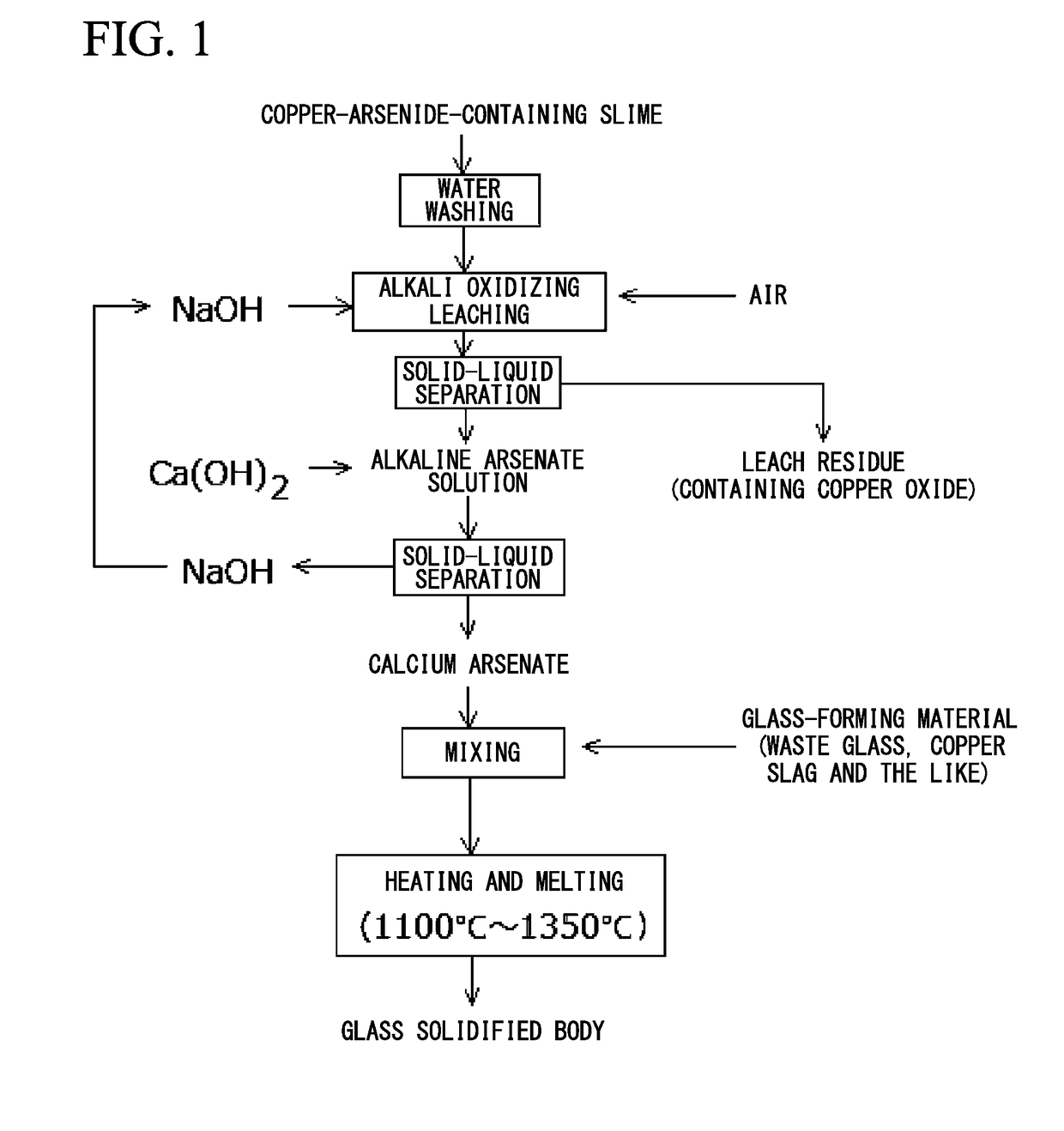Method for immobilizing arsenic, and arsenic-containing vitrified waste
a technology of vitrified waste and immobilization method, which is applied in the direction of sludge treatment, water/sludge/sewage treatment, transportation and packaging, etc., can solve the problems of copper quality, and achieve the effects of reducing the volume of the final disposal site, and ensuring the quality of the final produ
- Summary
- Abstract
- Description
- Claims
- Application Information
AI Technical Summary
Benefits of technology
Problems solved by technology
Method used
Image
Examples
example 1
[0060]100 g (dry weight) of a copper-arsenide-containing slime (As: 30 wt %, Cu: 60 wt %) was mixed with 0.5 L of a caustic soda solution (NaOH concentration of 65 g / L), and the mixture was stirred and heated to 85° C. Oxidizing leaching was performed while blowing air at a rate of 1 L / min. The leachate was subjected to solid-liquid separation, and a sodium arsenate solution was recovered. 32 g of calcium hydroxide was added to 500 ml of this sodium arsenate solution (As: 39 g / L, pH 10, 50° C.) and the mixture was stirred for 4 hours to generate a white precipitate (calcium arsenate precipitate). The slurry after the precipitate was formed was subjected to solid-liquid separation, and 64 g (dry weight) of the calcium arsenate precipitate (As: 30 wt %, Ca: 35 wt %) and 500 ml of the filtrate (As: 20 ppm, NaOH: 41 g / l) were recovered.
[0061]A glass-forming material obtained by mixing copper slag and silica sand was added to the recovered calcium arsenate so that an iron / silica weight r...
example 2
[0063]A mixture of copper slag and waste glass was used as a glass-forming material, and the glass-forming material was added to the calcium arsenate recovered in Example 1 so that the iron / silica weight ratio and the amount of alkaline components (total amount of Na2O and CaO) became the values shown in Table 1, and thereby, a mixed sample was prepared. This mixed sample was placed in a crucible and melted by heating at 1350° C. in the atmosphere for 30 minutes. The molten material was cooled to recover the glass solidified body. This glass solidified body was subjected to the arsenic elution test (in compliance with Notification No. 13 of the Ministry of the Environment). The composition of the glass solidified body and the result of the arsenic elution test are shown in Table 2 (Sample No. 21).
[0064]As shown in Table 2, in Sample No. 21 of the Example, the iron / silica weight ratio was in a range of 0.5 to 0.9, the amount of alkaline components was in a range of 14 wt % to 26 wt %...
PUM
| Property | Measurement | Unit |
|---|---|---|
| weight ratio | aaaaa | aaaaa |
| molar ratio | aaaaa | aaaaa |
| temperature | aaaaa | aaaaa |
Abstract
Description
Claims
Application Information
 Login to View More
Login to View More - R&D
- Intellectual Property
- Life Sciences
- Materials
- Tech Scout
- Unparalleled Data Quality
- Higher Quality Content
- 60% Fewer Hallucinations
Browse by: Latest US Patents, China's latest patents, Technical Efficacy Thesaurus, Application Domain, Technology Topic, Popular Technical Reports.
© 2025 PatSnap. All rights reserved.Legal|Privacy policy|Modern Slavery Act Transparency Statement|Sitemap|About US| Contact US: help@patsnap.com

